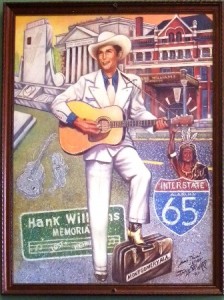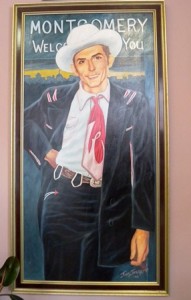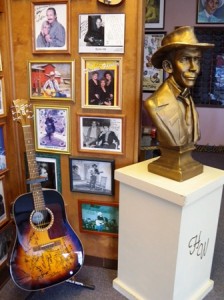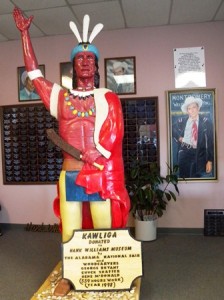» posted on Monday, January 21st, 2013 by Linda Lou Burton
Hey, Good Lookin’
 Linda Burton posting from Montgomery, Alabama – When Hank Williams moved to Montgomery in 1937 at the age of 14, Chris Katechis’ restaurant had already been open for twenty years. I’m sitting in Chris’ Place today, eating two of his famous hotdogs, beside a wall decorated in musical notes. I came in because I’d read that Hank Williams used to sit in Chris’ and write songs, and sure enough, I spotted a large poster of Hank as I came in the front door. “Do the musical notes have anything to do with Hank’s songwriting?” I asked my server, as she brought homemade onion rings stacked up cute like a tree. She went away to find out. The lady in the booth across the aisle had advised me on my order. “I worked here myself, back in the 60’s,” she told me, admitting she had no idea what was in the famous secret sauce Chris ladled over his hotdogs. “That’s why it’s called a secret,” she grinned. My server came back to tell me the musical notes on the wall were a part of the original décor, “just because Mr Chris liked
Linda Burton posting from Montgomery, Alabama – When Hank Williams moved to Montgomery in 1937 at the age of 14, Chris Katechis’ restaurant had already been open for twenty years. I’m sitting in Chris’ Place today, eating two of his famous hotdogs, beside a wall decorated in musical notes. I came in because I’d read that Hank Williams used to sit in Chris’ and write songs, and sure enough, I spotted a large poster of Hank as I came in the front door. “Do the musical notes have anything to do with Hank’s songwriting?” I asked my server, as she brought homemade onion rings stacked up cute like a tree. She went away to find out. The lady in the booth across the aisle had advised me on my order. “I worked here myself, back in the 60’s,” she told me, admitting she had no idea what was in the famous secret sauce Chris ladled over his hotdogs. “That’s why it’s called a secret,” she grinned. My server came back to tell me the musical notes on the wall were a part of the original décor, “just because Mr Chris liked  music,” she said. Enter Gus, a third generation Katechis, who sat down in my booth and told me a little more about the restaurant, and Hank. “There was a jukebox in here, and Hank always sat in the back booth. Sometimes he’d write, and always he drank. When he’d drunk a little too much, he’d start womanizing. And when he got a little too boisterous, my grandfather would help him out the door. But Hank was a good guy.” “What songs did he write in here?” I asked, but no one had the answer to that. “Maybe Hey, Good Lookin’, whatcha got cookin’?” Gus gave me his card and invited me to come back as often as I could.
music,” she said. Enter Gus, a third generation Katechis, who sat down in my booth and told me a little more about the restaurant, and Hank. “There was a jukebox in here, and Hank always sat in the back booth. Sometimes he’d write, and always he drank. When he’d drunk a little too much, he’d start womanizing. And when he got a little too boisterous, my grandfather would help him out the door. But Hank was a good guy.” “What songs did he write in here?” I asked, but no one had the answer to that. “Maybe Hey, Good Lookin’, whatcha got cookin’?” Gus gave me his card and invited me to come back as often as I could.
That song was in my head as I moved my car from Dexter Avenue to Commerce Street, and the Hank Williams Museum. Hey, hey, good lookin’, whatcha got cookin’? How’s about cookin’ somethin’ up with me? Hey, sweet baby, don’t you think maybe, we could find us a brand new recipe? I got a hot-rod Ford and a two-dollar bill and I know a spot right over the hill. There’s soda pop and the dancin’s free, so if you wanna have fun come along with me.
 They say that in order to write a good country song, you have to suffer a lot of heartache, and perhaps that’s why Hank Williams is thought of today as country music’s first superstar. He knew hard times and experienced both physical and emotional pain throughout his lifetime. He had spinal bifida as a child; the excruciating pain led to his dependence on pills and alcohol. His father was hospitalized when he was young and his mother had to support the family. He had successes with his own radio show in Montgomery at a young age, and his appearances at the Grand Ole Opry when he was in Nashville. He was let go from both for his drinking and unreliability. He was poor, and he had money jangling in his pockets. He had marriages, he had affairs, and he had divorces. Maybe that’s why song lyrics came so quickly to him, he knew what he was talking about. He is quoted as saying “If a song can’t be written in 20 minutes, it ain’t worth writing.”
They say that in order to write a good country song, you have to suffer a lot of heartache, and perhaps that’s why Hank Williams is thought of today as country music’s first superstar. He knew hard times and experienced both physical and emotional pain throughout his lifetime. He had spinal bifida as a child; the excruciating pain led to his dependence on pills and alcohol. His father was hospitalized when he was young and his mother had to support the family. He had successes with his own radio show in Montgomery at a young age, and his appearances at the Grand Ole Opry when he was in Nashville. He was let go from both for his drinking and unreliability. He was poor, and he had money jangling in his pockets. He had marriages, he had affairs, and he had divorces. Maybe that’s why song lyrics came so quickly to him, he knew what he was talking about. He is quoted as saying “If a song can’t be written in 20 minutes, it ain’t worth writing.”
 Hank Williams (1923-1953) was born in late September’s heat in rural Mount Olive, Alabama and died on a frosty cold night in the backseat of his 1952 powder blue Cadillac, somewhere between Knoxville, Tennessee and Oak Hill, West Virginia on his way to a concert. Like other music stars whose sad stories we have heard, his death was brought about due to a combination of alcohol and medication prescribed by a doctor. The Cadillac is on display in the Museum (don’t touch it or photograph it); as are many of the 40 pair of fancy cowboy boots he owned, along with personal and intimate family belongings, tapes of Grand Ole Opry shows, photos of other country artists, and displays of his
Hank Williams (1923-1953) was born in late September’s heat in rural Mount Olive, Alabama and died on a frosty cold night in the backseat of his 1952 powder blue Cadillac, somewhere between Knoxville, Tennessee and Oak Hill, West Virginia on his way to a concert. Like other music stars whose sad stories we have heard, his death was brought about due to a combination of alcohol and medication prescribed by a doctor. The Cadillac is on display in the Museum (don’t touch it or photograph it); as are many of the 40 pair of fancy cowboy boots he owned, along with personal and intimate family belongings, tapes of Grand Ole Opry shows, photos of other country artists, and displays of his  many record hits. You hear his voice as you walk around the Museum; does it take you back? Even if you aren’t a country music fan, you’ve heard songs he has written – artists as far from country music as Tony Bennett, Perry Como, and Dinah Washington have covered him. Although he could not read music, he wrote about 200 songs and had 11 #1 hit recordings between 1948 and 1953.
many record hits. You hear his voice as you walk around the Museum; does it take you back? Even if you aren’t a country music fan, you’ve heard songs he has written – artists as far from country music as Tony Bennett, Perry Como, and Dinah Washington have covered him. Although he could not read music, he wrote about 200 songs and had 11 #1 hit recordings between 1948 and 1953.
In 1961 he was inducted into the Country Music Hall of Fame; in 1985 the Alabama Music Hall of Fame. When Downbeat magazine took a poll the year after Hank’s death, he was voted the most popular country and Western performer of all time, ahead of such giants as Jimmie Rodgers, Roy Acuff, Red Foley, and Ernest Tubb. In 1977, a national organization of CB truck drivers voted Your Cheatin’ Heart as their favorite record of all time. In 1987, he was inducted in the Rock and Roll Hall of Fame under the category  Early Influence. In 1999, he was inducted into the Native American Music Hall of Fame. He was ranked second in CMT’s 40 Greatest Men of Country Music in 2003, behind Johnny Cash. In 2004 Rolling Stone ranked him number 74 on its list of the 100 Greatest Artists of All Time. Many rock and roll pioneers of the 1950s, such as Elvis Presley, Bob Dylan, Jerry Lee Lewis, Merle Haggard, Gene Vincent, Carl Perkins, Ricky Nelson, and Conway Twitty recorded Williams’ songs early in their careers.
Early Influence. In 1999, he was inducted into the Native American Music Hall of Fame. He was ranked second in CMT’s 40 Greatest Men of Country Music in 2003, behind Johnny Cash. In 2004 Rolling Stone ranked him number 74 on its list of the 100 Greatest Artists of All Time. Many rock and roll pioneers of the 1950s, such as Elvis Presley, Bob Dylan, Jerry Lee Lewis, Merle Haggard, Gene Vincent, Carl Perkins, Ricky Nelson, and Conway Twitty recorded Williams’ songs early in their careers.
In 2011 his 1949 MGM number one hit Lovesick Blues was inducted into the Recording Academy Grammy Hall Of Fame; that same year Hank Williams: The Complete Mother’s Best Recordings….Plus! was honored with a Grammy nomination for Best Historical Album. On April 12, 2010, the Pulitzer Prize Board awarded him a posthumous special citation that paid tribute to his “craftsmanship as a songwriter who expressed universal feelings with poignant simplicity and played a pivotal role in transforming country music into a major musical and cultural force in American life.”
Poignant simplicity. You feel that when you hear his heartbreak lyrics: I can’t stop loving you…your cheating heart, has made me weep…I cry and cry, and I can’t sleep….why can’t I free your doubtful mind and melt your cold cold heart….Even in all that sadness, Hank had a  kickass sense of humor too; one of my favorite songs as a kid was about the unrequited love of the wooden Indian named Kawliga, who never got a kiss; my Dad and I would sing together as we listened on the car radio. A brightly colored wooden Indian greets you as you walk into the Museum; I immediately heard my Dad’s voice and went spinning back to my childhood. That’s what Hank’s songs do; they take you to a point in your own life.
kickass sense of humor too; one of my favorite songs as a kid was about the unrequited love of the wooden Indian named Kawliga, who never got a kiss; my Dad and I would sing together as we listened on the car radio. A brightly colored wooden Indian greets you as you walk into the Museum; I immediately heard my Dad’s voice and went spinning back to my childhood. That’s what Hank’s songs do; they take you to a point in your own life.
Hank Williams’ funeral took place on January 4, 1953 at the Montgomery Auditorium; an estimated 25,000 people passed by his silver coffin. His funeral is said to have been larger than any held for a citizen of Alabama and the largest ever in Montgomery. He is buried at Oakwood Cemetery and his lifesize bronze statue stands in the park at Madison and Perry Streets.  September 21 is Hank Williams Day in Alabama and if you go to Lake Martin, you’ll see a historical marker near Kowaliga Bay, where he wrote the song Kawliga. You can also go to Chris’ Place on Dexter Avenue for a hotdog; it is part of the legend.
September 21 is Hank Williams Day in Alabama and if you go to Lake Martin, you’ll see a historical marker near Kowaliga Bay, where he wrote the song Kawliga. You can also go to Chris’ Place on Dexter Avenue for a hotdog; it is part of the legend.
Note: Hank Williams 11 #1 hits were: Lovesick Blues, Long Gone Lonesome Blues, Why Don’t You Love Me, Moanin’ the Blues, Cold Cold Heart, Hey Good Lookin’, Jambalaya (On the Bayou), I’ll Never Get Out of This World Alive, Kaw-Liga, Your Cheatin’ Heart, and Take These Chains from My Heart.
Hank Williams Museum, 118 Commerce Street, Montgomery, Alabama, 334-262-3600
Chris’ Hot Dogs, 138 Dexter Avenue, Montgomery, Alabama, 334-265-6850, http://www.chrishotdogs.com/
